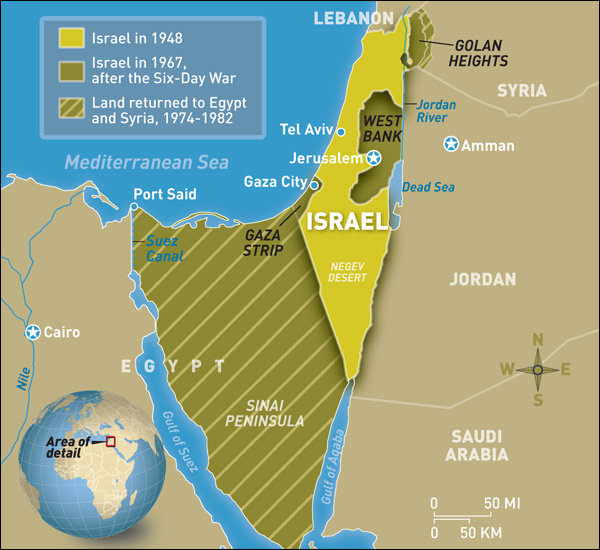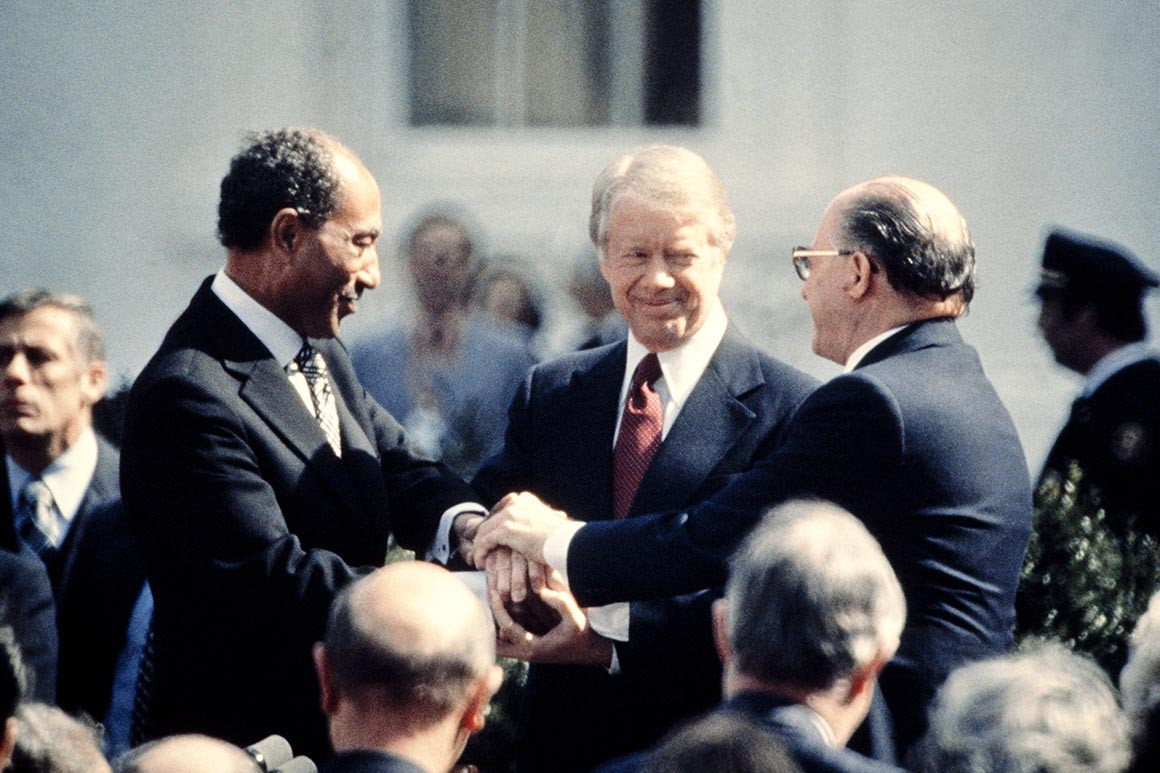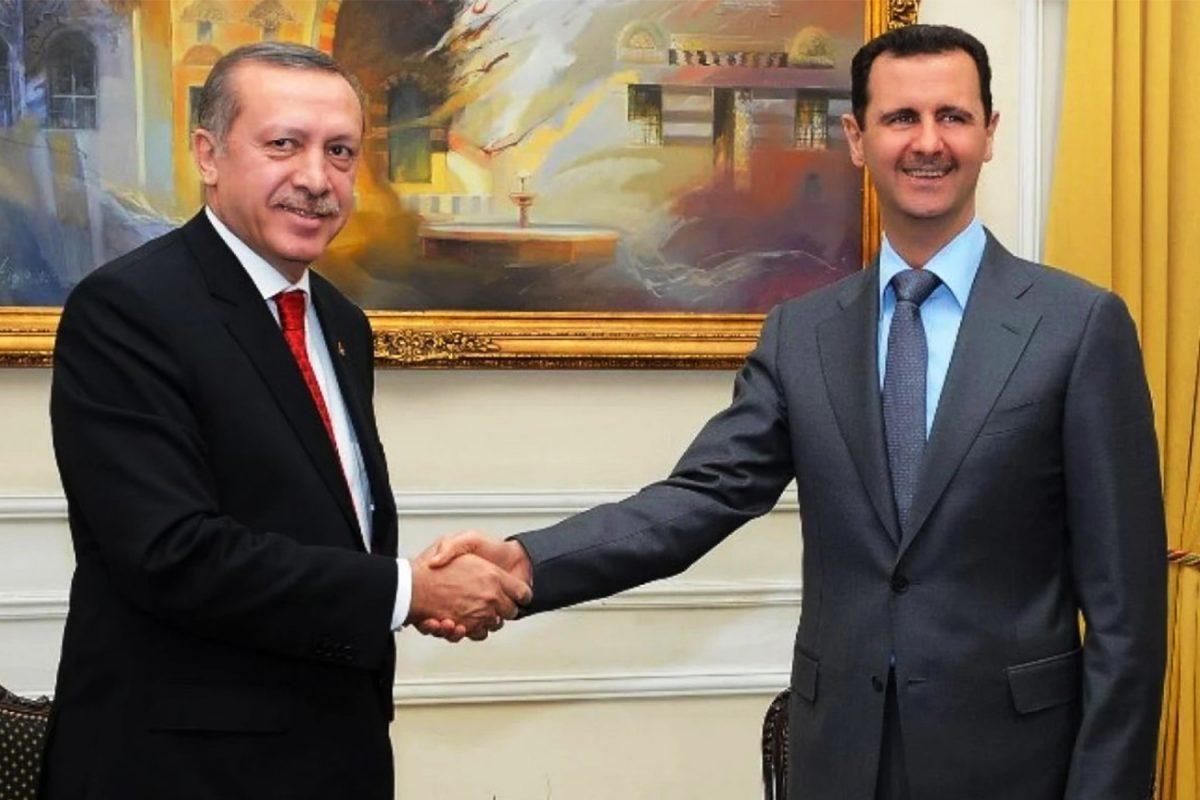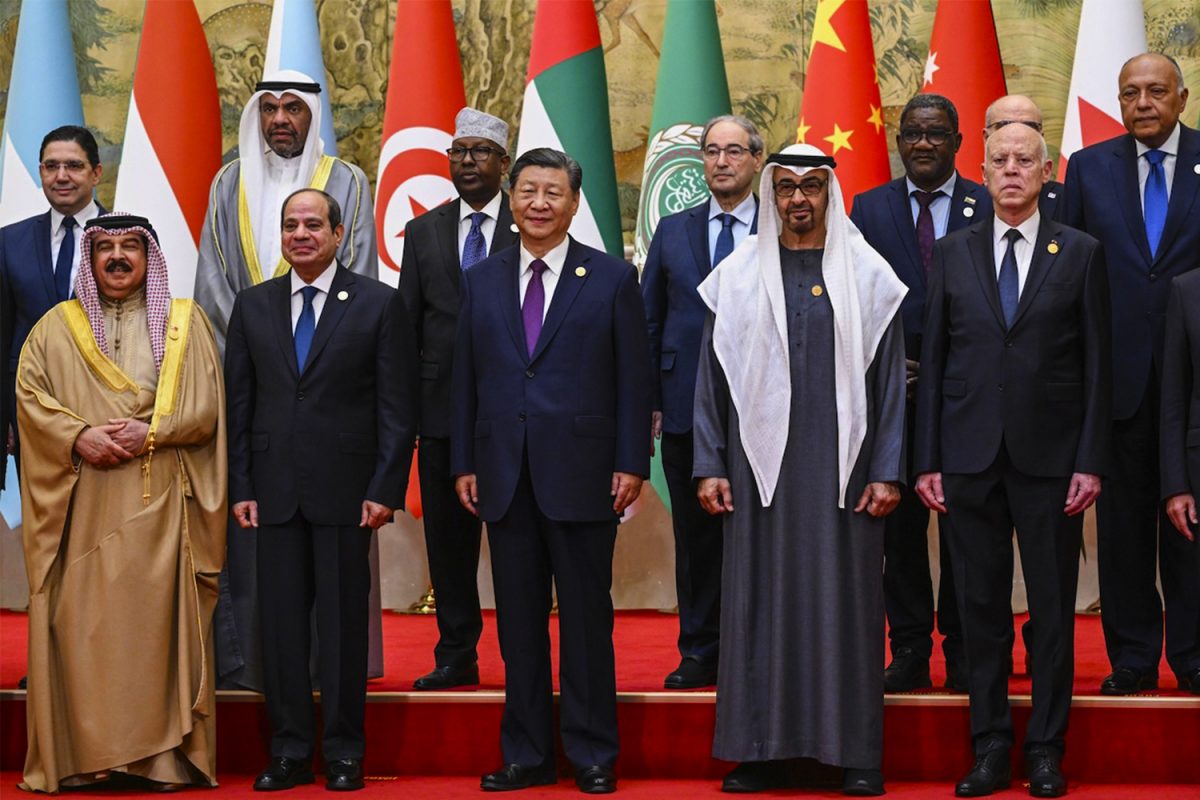Upon the creation of Israel in 1948 the indigenous people were expelled from their homes and a large exodus took place to the surrounding nations. Whilst Britain viewed Israel as a potential forward base in the region, she also faced numerous daunting challenges upon its creation. The nation’s precarious geographic, economic, military and strategic reality made survival such a difficult task that Israel’s first leaders had to deal with enemies who were vastly larger than the new small nation. From its outset it was surrounded by enemy nations on its southern, eastern and northern borders. Successfully dealing with its immediate neighbours was a strategic imperative if it wanted to survive – Egypt, Jordan and Syria came to represent formidable challenges on its frontiers.
From War to Peace
Egypt represented Israel’s most formidable threat upon its establishment. Being the cultural and poltical leader in the region, the Zionist annexation of Palestine brought Israel into direct conflict with Egypt. The coup in 1952 that overthrew the monarchy in Egypt and brought to power the Free Officers was made worse when Gamal Abdul Nasser proceeded to seize the moral leadership of the Arab world and began providing funding and training to the Palestinians in Gaza. Military raids were launched against Israel from the refugee camps in Gaza targeting Jewish settlers. The Israeli’s did not treat these attacks as a serious threat, however, this all changed in 1955 when Egypt acquired Russian armaments. This led the Israeli’s to believe that a pre-emptive war was the only way to stop Egypt from becoming a formidable threat and as a result Israel went to war with Egypt three times over 17 years.
Nasser’s nationalisation of the Suez Canal in 1956, which had hitherto been a British possession, gave Israel the pretext to launch an assault on Egypt. What made the Israelis confident was the support of Britain and France. Britain had been pushed out of Egypt by the coup in 1952 and was less than pleased with this loss of control over the Suez Canal, one of the main choke points for international trade. Nasser was also supporting the resistance in Algeria against France which turned the French against him. Britain, France and Israel all wanted to deal Nasser a fatal blow. The parties met in Sèvres, near Paris, and agreed to launch a military attack against Nasser to; enable Britain to take the Suez Canal back, enable Israel to occupy the Sinai desert, and enable France to block Nasser’s support for the independence fighters in Algeria.[1] Soon after the war broke out the Egyptian army was unable to put up resistance and Nasser quickly found himself at the end of the abyss. It took the intervention of the US and the USSR and their subsequent threats for Israel, Britain and France to back down. The difficulties experienced by Egypt during the Suez crisis contributed to a waning of support for the Palestinian cause. Nasser opened a channel of communication with the Israelis through the respective delegates of Egypt and Israel to the United Nations to explore the possibility of a permanent peace settlement.[2]
The difficulties experienced by Egypt during the Suez crisis contributed to a waning of support for the Palestinian cause. Nasser opened a channel of communication with the Israelis
Despite these secret talks, Israel saw Nasser and Egypt as a key imperative that had to be overcome. When Nasser forced oil tankers that were due to pass through the Tiran straits to submit documents ensuring their cargo was not destined for an Israeli port, this was effectively a blockade of 90% of Israel’s oil that transited through the Straits. Israel responded by launching a surprise attack against Egypt, Jordan and Syria on the 5th June 1967. With significant US supplies Israel captured the West Bank, Golan Heights, the Gaza strip and the Sinai within six days. America used its veto power at the UN when the Soviet Union demanded that the United Nations take action to ensure Israel withdrew. The six day war undermined Nasser credibility which he was unable to recover, it undermined the Soviet Union’s military capability as it was Soviet tanks and equipment Syria and Egypt were using. It also created the aura of Israeli military invincibility as it had defeated three Arab countries. Many came to believe the Arabs were culturally incapable of mastering modern warfare. The 1967 war changed the strategic dynamics as “Land for Peace,” was how the region would deal with Israel.

The Yom Kippur War launched in 1973 by Egypt and Syria against Israel was to solidify the positions of Anwar Sadat and Hafez al Assad who were relatively new leaders in countries prone to military coups. After a few days Israel became afraid she would be annihilated and the scenario that the Israelis would cease to exist was on the verge of coming true. But at this point, despite the immense strategic advantage, Anwar Sadat wanted to pursue peace talks. Negotiation at such an early stage in the war and Sadat’s refusal to press home his initial advantage allowed Israel to mobilize with a US “aerial bridge,” and to halt the Arab armies. [3].
The 1973 war completely devastated the idea that Israel could be militarily defeated. Whilst the actions of Sadat during the war raise many questions, especially the fact he did not press home the advantage his forces had, Sadat used the defeat to start direct talks with Israel for a lasting peace deal. In 1974 the two countries signed a formal treaty, which made Egypt the first Arab country to recognise Israel and accept her existence. After President Ford of the US held a series of meetings with Anwar Sadat of Egypt, King Hussein of Jordan, Prime Minister Khaddam of Syria (the first assistant of Hafez al-Assad) and Yitzak Rabin of Israel to finalise a regional framework, these were all formalised at Camp David in 1978. Israel promised to hand back control of the lands she had taken during the 1967 and 1973 wars and to allow the establishment of a Palestinian state, in return for formal recognition and acceptance of its existence.

With Egypt signing a peace deal and formally recognising Israel, this solved the most strategic dilemma Israel faced. The peace deal between them is the bedrock of Israeli national security. The treaty with Egypt removed the threat to the Negev and the southern coastal approaches to its capital – Tel Aviv – Israel no longer needed to worry about its Southern border. With the regional power recognising Israel, this ended the major nation state threats to Israel and many of the rulers in the region began secret talks with Israel to normalise relations.
The Battle for Syria’s Strategic Heights
Compared to Egypt, Syria presented a different challenge to Israel. Syria could hurt Israel but it did not represent an existential challenge. The border between the two countries contained Lake Tiberias,’ the Hula Lake (a marsh), upper Jordan and its main tributary, the Banyas and the Golan Heights. The water sources in this area were essential for Israel but also for Syria. The heights also provided a military advantage to who occupied them. Both countries, despite their avid hatred toward each other, have regularly held peace talks in secret despite their public accusations against each other.
During the 1948 Arab-Israeli war, Syria occupied the northeastern section of Lake Tiberias and the banks of the Banyas. Whilst the newly created Israel occupied other parts of the mountain heights but claimed sovereignty over the whole area. Despite this Husni Za‘im in 1949 and Adib Shishakli in 1952, offered to conclude a peace deal with Israel. They offered to absorb hundreds or thousands of Palestinian refugees, sovereignty over the eastern sections of the Tiberias (half the lake) and Hula Lakes and American financial and military aid to Syria. Israel refused to negotiate with the tertiary it held.
In the final phase of the June 1967 six day War, Israeli forces occupied the Golan plateau. There was a bizarre situation when Israel seized the Golan Heights, the Syrian troops occupying the Golan Heights heard news of Israel’s capture of the strategically important heights through their own State radio announcing the Israeli capture of the heights while the Syrian troops were still clearly occupying them. The capture of the Golan heights provided Israel with the water security it desperately needed and also the strategic advantage of occupying the heights.
In the final phase of the June 1967 six day War, Israeli forces occupied the Golan plateau. There was a bizarre situation when Israel seized the Golan Heights, the Syrian troops occupying the Golan Heights heard news of Israel’s capture of the strategically important heights through their own State radio announcing the Israeli capture of the heights while the Syrian troops were still clearly occupying them
With the 1973 war Syrian forces were able to capture the entire Golan Heights and held it for several days before losing it again to Israel. On this occasion Israel significantly stepped up its settlement policy to ensure permanent occupation of the strategic area. Despite this Hafeez al-Assad publicly offered to sign a non-belligerency peace agreement with Israel in return for total Israeli withdrawal from the Golan Heights.[5]
By the 1980s Syria lost the support of the Soviet Union, who itself was in decline and had for long provided the country with military platforms. Mikhail Gorbachev bluntly told Hafiz al-Assad in April 1987 that “the reliance on military force in settling the Arab-Israeli conflict has completely lost its credibility,” and urged him to seek a political settlement to the conflict with Israel.[6] Syria joined the US in the 1991 invasion of Kuwait and turned to the US to resolve the issue of the return of the Golan heights, despite numerous talks during the 1990s, 2004 and 2010 no formal peace talks have succeeded and this is primarily due to Israel refusing to give up the strategic Golan heights.
The capture of the Golan heights and the surrounding areas gave Israel the much needed security it needed in the north of its border. Hafeez and his successor Bashar al-Assad separated their peace deal from the Palestinian issue, hoping Israel would give concessions, which it had refused to do. In the case of Syria, it is Syria who wants to normalise relations with Israel and the Israeli leadership is dragging its feet as it’s in the stronger position occupying and keeping the strategic Golan area.
Peace not War
Jordan much like Israel was an artificial creation in the region, it was a reward to the Sharif Hussains family for the Arab revolt against the Ottomans in 1917. Israel’s longest border is with Jordan and where this border would be has been a key strategic imperative for Israel. But unlike the other countries on its borders the Hashemite Monarchy in Jordan has always had cordial relations with successive Israeli administrations in private despite its public rhetoric.
 Even before Israel’s creation, Sheriff Hussein’s sons sought relations with leading Zionists. Sharif Hussains eldest son, Abdullah, and Israel’s first Prime Minister, David Ben Gurion, were students together in Istanbul. In early clandestine meetings, Abdullah had offered to accept the establishment of Israel in return for Jordanian control of the Arab populated parts of Palestine. Israel and the Hashemite monarchy have had a number of ‘back-channel’ and at times clandestine communications that often resulted in accommodations even during times of war.
Even before Israel’s creation, Sheriff Hussein’s sons sought relations with leading Zionists. Sharif Hussains eldest son, Abdullah, and Israel’s first Prime Minister, David Ben Gurion, were students together in Istanbul. In early clandestine meetings, Abdullah had offered to accept the establishment of Israel in return for Jordanian control of the Arab populated parts of Palestine. Israel and the Hashemite monarchy have had a number of ‘back-channel’ and at times clandestine communications that often resulted in accommodations even during times of war.
Israel found the country it has its longest border with lacked natural resources and the ability to develop an economy which allows a basic standard of living for its people, even with its small population. Jordan never posed a military threat to Israel and the monarchy was more than willing to negotiate and concede for its own survival. From Jordan, Israel seized the West Bank and east Jerusalem in the 1967 war after reassuring King Hussain that Israel did not seek confrontation with Jordan. King Hussein as a result positioned his troops in different areas from where the main battle took place. The Hashemites maintained public outrage of this loss but in private opened talks for negotiations over the West Bank.
Israel’s Air Force came to Kings Hussain’s rescue in 1970 when he waged war against the Palestinian Liberation Organization (PLO), and as thousands of Palestinians based in the Kingdom began to threaten his rule. When Syrian troops invaded the Kingdom, the Israeli air force made a series of overflights against them. Mossad had warned Hussein about a Palestinian assassination attempt. In the 1973 Yom Kippur War Hussein in covert face-to-face meetings with Israeli Prime Minister, Golda Meir informed her of his intention to stay out of any future war and warned her about Egyptian and Syrian threats that would eventually lead to war in 1973.
In 1987 Israeli Foreign Affairs Minister, Shimon Peres, and King Hussein tried to secretly arrange a peace agreement in which Israel would concede parts of the West Bank to Jordan. The two signed the Peres–Hussein London Agreement, defining a framework for a Middle Eastern peace conference. The proposal was not accepted due to Israeli Prime Minister Yitzhak Shamir’s objection. But these links were used in the early 1990s to formalise the long-standing relationship and in 1994 the Israel–Jordan peace treaty was signed in Washington which resulted in normalizing ties between the two. Jordan abandoned its claim to the West Bank and the treaty allowed Israel to maintain its borders, have control over the waters in the Yarmouk river and opened intelligence exchanges between the two nations. In this way Israel secured its longest and most vulnerable border along the Jordan River.

By the turn of the 21st century when Israel reached its 5th decade of existence the nations on its frontiers, and who represented the most gravest threat, had been neutralised. This was achieved through wars, secret talks and significant US help. Israel was able to divide and effectively make peace with two of the four nations that bordered it. It was able to achieve this as the Arab rulers went against public opinion in their own nations and entered full normalisation talks with the enemy (as far as the masses were concerned). Once Egypt, Syria and Jordan abandoned war as a means to liberate Palestine, Israel as a permanent part of the region was achieved. Israel’s border with Lebanon never presented an existential threat. The 1982 invasion of Lebanon, the various intifadas and the wars with Hezbollah in 2006 and Hamas in Gaza in 2008, Israeli interests were involved, but its survival was never in question. There were still threats to Israel further in the region but its strategic imperative of security with its immediate neighbours had been neutralised.
[1] The Iron Wall: Israel and the Arab World,” Avi Shlaim, 2001 and see, http://en.wikipedia.org/wiki/Protocol_of_Sèvres
[2] David A. Nichols, Eisenhower 1956: The President’s Year of Crisis, Suez and the Brink of War, 2011 and Britain, Nasser and the Outbreak of the Six Day War, Robert McNamara, Journal of Contemporary History, October 2000, www.jstor.org/stable/261063
[3] The Impact of American Arms Transfers to Israel during the 1973 Yom Kippur War, David Rodman, Israel Council of Foreign Relations, https://www.tandfonline.com/doi/abs/10.1080/23739770.2013.11446570
[4] Yitzhak Rabin, Pinkas Sherut (in Hebrew, Tel Aviv, 1979) pp. 442, 447, 471, 475
[5] Syria and Israel: From War to Peacemaking, Moshe Ma‘oz, (Oxford, Oxford University Press, 1995) pp. 145-147
[6] Ephraim Karsh, The Soviet Union and Syria (London, 1988) p92





2 comments
Aijaz Rasool
13th October 2020 at 10:16 am
Best Chronological analysis
Hassan
5th September 2022 at 10:20 am
Just splendid